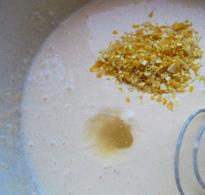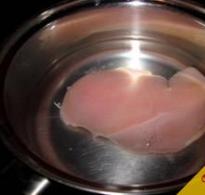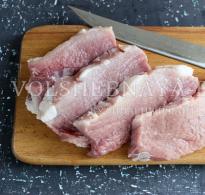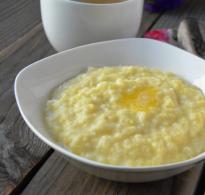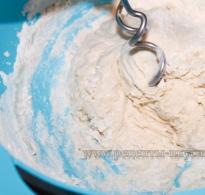Separate the bones from the meat on the chicken. How to separate meat from bones
Do you want to impress your guests by serving boneless turkey or chicken, but are confused about how to do it or afraid that you won't succeed? Although separating the meat is not the most pleasant task, it is relatively easy to do, you just need to set aside a little time for this. As a result, poultry meat can be cooked faster, so the game is worth the candle.
Steps
Part 1
Prepare for the Separation Process- Tie up your hair. It's not worth risking your own hair as part of the stuffing, unless you're planning on eating the whole bird yourself.
-
Prepare your work surface. When separating the meat from the bones, there will be a lot of dirt, and you will need a fairly large surface (especially if it is a 9 kg turkey). Make sure you have somewhere to "turn around". You can cover the countertop with a large trash bag by placing a cutting board on top.
- Don't skip the cutting board. You will need something under the bird to make it easier to lift and turn.
-
Expand the bird. In the kitchen sink, remove the plastic shell that the bird is sold in. Also remove the fasteners holding the legs together. Then open the abdominal cavity and gut all the insides. Many poultry farmers put paper-wrapped offal into the abdominal cavity.
- Get rid of everything superfluous, including threads. You will need new threads when you tie it back.
-
Lay the bird breast side down on a cutting board. The breast can be distinguished from the back by the "hollow" descending down, which divides the breast into right and left halves. On the back, you can feel the spine. When the bird lies breast up, then its legs (shins) are directed slightly upwards. When the bird lies breast down, it looks like it is kneeling on a cutting board.
- You can probably also tell from the location of the wings and legs which is the front and which is the back. If not, then it is better to look for the location of the cavity.
Part 2
Separate and cut the joints-
Cut the skin along the spine. You can cut the leather in several places, then flip the knife over and cut the leather from the bottom. You may also find that it is easier to cut only on the left or right side of the spine. In the subsequent steps of separating the meat from the bones, be careful not to cut the skin.
- It is best when the knife is clean and sharp. A dull knife is harder to wield and will result in uneven cuts. Still, be careful. You can, for example, get stuck in some area and you have to apply more force, risking cutting yourself. Be careful and take your time.
-
Start removing the meat from the chest. Grab the skin with one hand and (carefully!) cut the meat off the bone. Grasp the skin next to the spinal incision furthest away from you first. Cut as close to the bone as possible.
- You have to feel around to find where the bones are, and then move towards the beginning until you hit the breast bone. Just walk around it as carefully as possible. You can bend the bone until it comes off the chest and then pull it out. It will be easier.
-
Hold the cut meat and separate it from the chest. Slowly move down from the back, sideways, towards the chest. It's okay if you cut pieces of bones, cartilage, or tendons along with the meat; this can be easily corrected later. Remove as much meat from the bones as possible. Start slowly and make small cuts until you've got your hand full.
- Try not to accidentally cut the skin from the inside. Continue to separate the meat from the ribcage until you reach the leg and wing joints. After making small incisions, clear the area around each joint so that you can see as much of the joint as possible.
-
Stick out the wing joint. Put down the knife and take the wing in one hand, and with the other hand grasp the area around the wing joint. Bend the wing back and twist it a little until the joint crackles. You need to do this so that you can then cut through it and separate the bones.
- As soon as the wing crackles, you will notice that it will go limp (meaning detached from the body).
-
Cut the wing joint. Reach out with the tip of the knife and find the gap between the wing bone and the articular fossa. You just created this gap when you broke the joint. Keep looking for him, even if it's not easy. Move the wing until you see the joint - it's white. Cut the wing joint and tendon, being careful not to cut through the skin.
- If you cut through the skin, don't worry. The bird can be tied up and the meat will still be tasty - the appearance simply depends on it. Towards the end of the article, we will tell you what to do if this does happen (so don't worry about it for now).
-
Stick out the leg joint. Grab your leg with one hand and grasp the area around the leg joint with the other. Bend your leg back and twist it a little until the joint crackles. Do it in the same way as you already cut the wing joint. Is it getting better?
- Again, if this is not done, then the entire half of the skeleton will still be connected, which will make it very difficult (or almost impossible) to remove the bones from the meat. You are essentially separating the bones from each other so that they can be released more easily.
-
Cut the leg joint. Reach out with the tip of the knife and find the gap between the leg bone and the articular fossa. You just created this gap when you broke the joint. Keep looking for him, even if it's not easy. Move your leg until you see the joint - it's white. Cut the leg joint and tendons, being careful not to cut through the skin.
- The joint, when you see it, will resemble a white hard ball - it's hard to miss it.
Part 3
Separate meat and bones-
Continue cutting the meat off the bones. Cut the meat off the bones and come to a sudden stop in front of the sternum (cartilaginous sternum). This is where the bones are closest to the skin, so stop here for a while.
- We will return to this a little later. As long as there are other parts to clean up. It will be easier if you first get rid of everything superfluous.
-
Clean up the other side. Turn the bird and do the other side. You can either turn the bird around or turn the cutting board along with the bird. Start at the spine and following the instructions above, remove the meat from the bones on the other side of the bird.
- Stick out and cut through the wing joints and legs in the same way as before, wiggle them until you see the white joints and connecting tendons.
-
Carefully separate the skin from the breastbone. Lifting the chest with one hand, carefully cut the meat from the breast bone. Be very careful at this stage not to cut through the skin. In this place, the skin is very close to the sternum. Peel off the last edge where the bones meet the meat and remove it.
- But don't throw it away! You can use it for strong broth. Grandma would be proud of you.
-
Locate and remove small pieces of bone. You should now have a very large, smooth piece of meat in front of you. Run your hand along the surface of the meat and feel for small pieces of bone, cartilage, etc. that you may have cut off along with the meat.
- This is absolutely normal and happens even to experienced chefs. Cut them off and throw them away.
-
Remove the bones from the legs. You can also clean the legs if you like, but this is not required. Some prefer to leave their legs with bones to serve. To remove the thigh bone, cut off the meat from the top of the thigh bone and around the bone. Stick out the joint between the leg bones, cut through the cartilage and remove the thigh bones.
- Again, this is very similar to what you did with the wings. The only difference will be in the bone structure and how you can grab onto it.
Part 4
Stuff, sew and finish what you started-
Stuff and sew up the bird. You can do one of two things: sew the bird up and then stuff it, or put stuffing on it and then sew it up. Either way, fold the two edges of the bird back to the middle and sew using strong kitchen twine. You can make a needle out of a large paper clip, and you can push it in and out with pliers. Be sure to sew not only the skin, but also partially the meat, because the skin can tear if you only sew through it.
-
Tie up your legs. After sewing up the bird, turn it over so that it is breast-side up. Due to the fact that you have separated the meat from the bones, it will look soft, and the legs will move apart like in a yoga pose. You can secure the legs with kitchen string.
- Even if you leave the bones inside, you can still tie the string around your legs. The legs will lack support from the entire skeletal structure, and if they are not tied they will still sag.
First, put on clothes that you don't mind. Butchering a bird is, of course, not a very pleasant process and also a little dirty. Put on a T-shirt that you can get dirty. It should be clean as you are cooking. It is better if it is with short sleeves or sleeves that can be rolled up securely so that they do not interfere.
After the pig is slaughtered and bled, and the internal organs are removed from the carcass, the pig is cut. Simply cutting the meat into pieces in a random order, separating the heart and other organs, is the wrong decision, a certain scheme for cutting the carcass must be followed. How to do this correctly and where are the main parts of the pig carcass located?
Before butchering a pig, you need to determine what the meat will be used for: for yourself or for sale, how the pork will be cooked, etc. In accordance with the purpose, one or another scheme for cutting a pig carcass is selected.
When this issue is resolved, the workplace should be prepared. It is most convenient to butcher a pig right at the slaughter site, without removing it from the hooks. If the animal was slaughtered on the ground, it is not necessary to hang the carcass on a crossbar specifically for cutting.
It is also necessary to choose the right tool for butchering a pig. In order to maximize the yield of pure meat as a percentage of the live weight of the animal, it is necessary not only to work carefully, but also to use high-quality, sharply sharpened knives. For cutting you will need:
- Knives - each knife must be sharpened, have a blade length of 15 cm and a width of 2 cm;
- Hand saw with a wide blade;
- Hooks, if the carcass is butchered in limbo;
- Hot water container;
- The desktop is not metal, wood or concrete should be used.
A pig can be butchered only after draining the blood from the carcass. Wash the meat beforehand, so that it does not start to spoil quickly.
Carcass cutting schemes
There are 4 main schemes for cutting pork carcasses: German, Russian, English and American. They involve cutting the carcass into 4-8 pieces in a different order. First of all, the parts that the pig strained the least during life are cut out - they are more tender and tastier. These are the spinal muscles that run along the spine, the scapular part and the neck meat.
German scheme the most popular, since it is possible to properly butcher a pig into a larger number of parts. Previously, the carcass is divided into two half-carcasses, each of which consists of 8 parts - in total, 16 pieces of meat are obtained, belonging to different quality classes.
German cutting scheme
- Grade 1 - back leg (ham), lower back and cutlet part;
- Grade 2 - the anterior section of the vertebral muscles, the ham of the front leg and the brisket;
- Grade 3 - abdominal meat;
- Grade 4 - head and legs, except for hams.
English scheme cutting pork is the simplest: the half carcass is divided into 4 large pieces (head, front, middle and back). This cutting method should be chosen if the animal is slaughtered for sale.
 English cutting scheme
English cutting scheme Russian scheme similar to German and also involves cutting into 8 parts. The following parts of the pork carcass are obtained: ham, back, area between the neck and shoulder blades, head with neck, shoulder blade, breast, middle sections of the legs and legs.
 Russian (Moscow) cutting scheme
Russian (Moscow) cutting scheme Simplified American scheme includes 6 pieces of carcass. The loin is not separated from the back, the neck is not separated from the head, the legs are not divided and are cut along with the legs. The advantage of the method is that when using it, the pork shoulder is cut out separately.
 American cutting scheme
American cutting scheme There is no significant difference between the schemes - you can decide how to butcher a boar on an individual basis, as it will be more convenient.
Procedure for cutting
Pig decapitation
The head is separated from the pork carcass first. Before cutting a pig's head, you need to cut it off correctly - it holds tight, so without knowledge of the working technology it is easy to damage the knife. The head is cut off as follows:
- Two incisions are made behind the ears;
- The knife is inserted transversely into one of the incisions, after which a throat incision is made from ear to ear;
- The cervical vertebrae are sawn with a hacksaw with fine teeth.
- Hooves are also cut off with a saw.
Cutting a pig's head
After decapitation, the pig's head is cut. The procedure is quite simple: you just need to cut this part of the body into two pieces and remove the eyes and teeth. The brain is removed and used in cooking, it should not be thrown away. The heart is also used from the internal organs. If the head is being prepared for sale, it is not necessary to cut it.
Removal of the abdominal apron and internal organs
Cutting the carcass begins with the fact that the abdominal apron is cut off from the decapitated residue. The muscles of the peritoneum are cut out along with the fat; this must be done carefully, trying not to damage the internal organs - their contents can penetrate the meat and spoil its taste. When the abdominal apron is removed, the insides are removed from the carcass in the following order: large organs (lungs, liver, stomach), bladder and kidney part. Most of them can be thrown away, only the heart and liver are used for food. The heart must be cut into two pieces and cleaned of clotted blood.
Cutting the carcass into pieces
The devastated carcass is cleaned of blood residues with the help of napkins and cut or sawn into two half carcasses. Before continuing work, each half carcass of pork meat must be cooled.
- Fat and fat are separated from the skin;
- The neck part is cut out;
- The front leg is cut off from the half carcass, the shank is separated from the shoulder part;
- The back ham is separated;
- Cut off pork loin and brisket.
Each part can be cut into several more pieces - for example, to separate the rump from the back or cut the ham into small pieces - depending on how it will be more convenient to handle the meat in the future.
Cutting a piglet is somewhat different - you only need to bleed and gut the carcass, you don’t need to divide it into pieces, because due to its small size it is baked whole.
Meat Yield Calculation
Some part of the mass of a live pig is lost during the cutting process: the blood and internal organs of the animal have a significant weight. Also, from the live weight, you need to subtract the mass of bones, tendons, joints, etc. The product that remains after cleaning the carcass, cutting the pork side, separating the meat from the bones and removing the film covering the muscles is called pork exit.
Yield is calculated as a percentage of the live weight of the animal. It can be different depending on the breed of the pig, its sex, age, butchering skill and other factors. On average, the yield is 60–70%, in some cases reaching up to 78–80%.
The main parts of the pork carcass
Before cutting a pig carcass into separate pieces, using a knife, for sale or for your own use, you should figure out which part of the pig is tastier and where which one is located. If the meat is prepared for sale, the most valuable parts, such as the carbonate in a pig or a pork loin, must be handled with particular care.
 Pork parts
Pork parts Ham
The largest part of the carcass is the back leg. Since it is better to cut the carcass of a pig into such pieces that it is convenient to handle them, the ham is often divided into two pieces along the thigh line. There are more muscles in the upper half, so it goes to various meat dishes; the lower half of the ham is used to make jellied meat.
Shoulder blade and neck
The shoulder and neck are divided into three pieces: clean shoulder meat, shoulder bone and neck meat. Since the pig's neck is practically immobile throughout life, its meat is very tender. The shoulder blade, on the contrary, is tough, and requires careful cooking.
knuckle
The knuckle of a pig is the least valuable, as it consists of the toughest meat and cartilage. It can be smoked or put on jellied meat.
tenderloin
Pork tenderloin - the most tender part, it is located along the spine of the animal. Pork tenderloin is used for cooking chops and is part of the carbonate - the part of pork that runs along the entire spinal column and captures the psoas muscles. From it you can cook almost any dish. Another part of the back is a loin that captures the ribs. The back ends with a rump, from which kebabs are prepared.
Abdominal apron, head and internal organs
The abdominal apron of the animal is divided into the brisket, peritoneum and underbelly. The head is divided into cheeks for bacon and a tongue well suited for aspic. The rest is finely chopped and goes to the jelly. Internal organs (heart and liver) can also be eaten, although they are less tasty than cow giblets. Thus, cutting a wild boar involves the use of almost all parts of the carcass.
Video: "Cutting up a pig for sale"
Knowing which part of the pork is used for what purposes, you can quickly and correctly get the right pieces of meat from the pork carcass. The main thing when cutting is to use a good knife and follow the chosen pattern exactly.
To make the cooking process quick and easy, you need to know how to separate the meat from the bone. All you need is a cutting board and a sharp knife. In some cases, kitchen scissors may be needed.
How to cut meat from bone? A knife and cutting board will help you with this
Rabbit is a rare guest on our tables. It is important to properly cut the carcass so as not to spoil the taste of the finished dish.
How to separate rabbit meat from bones?
Keep in mind that the rabbit has strong tubular bones. If you cut them, you get a lot of small fragments that can get stuck in the meat. Therefore, it is better to cook dishes from this animal with whole bones.
The division takes place in several stages:
- Start with the back legs. Cut the skin along the spine with a knife and separate the paws at the joint.
- Next comes the belly. There are no problems with him. A piece of clean meat is easily separated from the carcass.
- It's time for the fillets. Cutting should start from the pelvic region and lead with a knife to the neck along the ridge.
- The next step is to remove the front legs. They easily move away from the body, because they are not attached to it by bones.
- Now you need to divide the carcass into 2 parts in the lumbar region, breaking the spine. Clear the pieces of muscle and tendons.
- Ribs can be cut with scissors. Movement should be directed along the spine.
- The last step is to cut the back into several pieces, being careful not to damage the bones.
Now the rabbit can be cooked according to your favorite recipe.
How to separate chicken meat from bones?
Buying a whole chicken and butchering it yourself will be cheaper than buying one already cut in the store. This process is not difficult. Take a look at the video on how to separate chicken meat from the bones, and get to work.
But there is another way to cut chicken. You need:
- Lay the bird back up and make 2 cuts along the spine to remove it.
- Next, you need to get rid of the thymus bone, which connects the sternum to the wings. To do this, turn the chicken breast side up, cut the bone and remove it.
- Now you need to separate the sternum. The lower part comes off very easily, just trim the ribs. Next, you need to cut around the sternum, lift it up and cut the cartilage that connects it to the humerus.
- When the sternum is done away with, it’s worth doing the hips. You need to find the thigh bone and just cut it off.
- Then you need to remove the tips of the wings. They separate easily.
The chicken is ready. It will cook evenly and easily.
Chicken dishes are very popular not only among those who have decided to devote their lives to diets. From chicken, you can cook a lot of different yummy for both the everyday table and the festive one. The only thing that confuses not very experienced housewives is how to cut the chicken correctly so that the pieces in the dish are even, neat and look aesthetically pleasing.
For those who are completely unfamiliar with the process, there is one “tricky” advice: you can bake the whole “bird” and, after serving it to the table, ask the man to divide the finished dish into portions. Well, if the menu says stuffed chicken, chicken roll or stewed chicken pieces, then you have to tinker with it yourself. And to help everyone who doubts their abilities, a whole set of tips on how to butcher a chicken carcass.
Standard cutting scheme
There are several ways to butcher a whole chicken. Their total number is divided into methods for dividing the carcass into parts and methods for separating meat from bones.
Partitioning usually involves obtaining eight pieces of chicken as a result, and separation from the bones - the most whole and not spoiled by unnecessary cuts and gusts of a carcass, completely devoid of a frame.
Common to all modes of action:
- thoroughly wash and gut the chicken;
- cut the carcass correctly and evenly;
- separate the wings (since it is very inconvenient to separate the bones from this part of the chicken, it is better to get rid of the wings even if stuffing or making a roll).
- separate the legs
- cut the legs into shin and femur parts;
- separate the breast.
If the carcass needs to be freed from the bones, leaving the meat and skin intact (this is the way to cut the chicken for a roll), you can act in an open way: through a cut on the breast or back.
The traditional way: eight pieces of chicken
This cutting method is suitable for barbecue, roasting and stewing chicken.
Tools: sharp knife and kitchen scissors.

Even if you are not quite sure how to butcher the chicken, in this case everything will work out correctly, since the essence of the process is to separate the “protruding” parts (legs and wings) from the carcass and divide the remaining part into portions.

in half
Another popular way is cutting the chicken in two. How to butcher a chicken to cook tobacco chicken is known and able to do by most housewives. For them we will repeat, and we will teach the inexperienced.

- Place the chicken traditionally - breast up and, holding the tail, make cuts on both sides of the spine. Remove the spine.
- Make an incision in the breast bone (what is called the keel) and then open the carcass to the sides. The keel can be removed by simply pulling it out of the pulp.
- The chicken can be left open, or it can be divided lengthwise into two even parts - depending on which recipe needs to be implemented.
Bone removal
This process of the hostess is called the most difficult during the cutting of poultry. The bone and meat hold together quite tightly, and the goal of the cook is to separate them so carefully as not to damage the skin and prepare an aesthetic dish as a result.
Removal of bones is the most time-consuming and requiring attention and care stage of cutting.

How to cut a chicken for a roll, how to preserve the integrity of the skin for stuffed poultry, how to guarantee maximum presentability to the finished dish? Only very carefully getting rid of the frame.
There are two well-known methods: open and closed. The first involves one "through" incision, and the second (it is more complex) is based on eversion of the carcass, like a stocking.
open way
You need to start cutting along the back, since there is less meat in this part of the chicken, and the ribs are closer to the surface.
- With a sharp knife blade, separate the meat from the skeleton, starting from the tail area.
- When cutting meat from the ribs, you need to simultaneously deal with both the leg and the wing, breaking them off in the part of the connection with the skeleton.
- Meat with skin on the leg must be removed using the stocking method.
- As for the bones in the wings, removing them is so difficult and inconvenient that it is easier to simply remove the wing if the recipe does not require the presence of this part of the chicken in the finished dish.
Closed way
To understand how to cut a chicken from the bones using a closed method, it is enough to remember turning the uncomfortable heavy things of your wardrobe inside out. These are very similar processes. Only in the case of a chicken, you also need to cut the bones, and remove the tendons, and make sure that the "bird" does not want to tear.
- The beginning of cutting is the place of gutting. It is necessary to carefully cut the tail on both sides (but not remove it), exposing the ischium.
- Gradually cutting the meat in a circle, continue to “turn out” the chicken, exposing more and more of the skeleton.
- At the junction of the legs with the skeleton, it is necessary to separate them from the main part of the carcass with a sharp and precise movement and continue turning the chicken further, you can do the legs later.
- Separate the fillet from the keel, break off the wings along the joint line. Again, the wings can be removed due to the extreme difficulty of cutting from the bones.
- It is necessary to clean the meat and skin from the legs in a circle, turning and chopping off the bones at the joints.
Sanitary standards
The main thing in preparing a carcass is not only how to cut a chicken, that is, the process itself, but also the conditions in which it is produced.

The board for raw meat must be used exclusively for its intended purpose, otherwise troubles cannot be avoided in the form of a possible contamination of other products with bacteria.
The cutting knife must be clean and always sharp.
Gloves during butchering poultry are needed to protect against the same bacteria present in raw meat, and in the case of butchering finished poultry, they will protect hands from burns.
A common truth: the table and kitchen utensils must be washed in hot water before and after cutting.
Meat separated from bones used in the preparation of various types of dishes. Prepare a sharp knife and cutting board for cutting meat. Separate meat from bones possible in several stages.
Choose your recipe
You will need
- Sharp knife, cutting board.
Instruction
Prepare a small sharp knife for cutting lamb. Meat fairly easy to separate from bones. Some pieces of meat can be removed even with your fingers. But it is better to separate large layers of meat with a knife, firmly pressing its edge to the bone. This will cut off most of the meat, leaving the bone almost bare. When cutting the neck, some skill is required. The cervical vertebrae are cut out in turn with a knife. Lamb belly is relatively easy to clean. bones. To remove it, you must first separate the edges. They are carefully twisted by hand. Remove the bones from the shoulder blades so that you have a flat piece of meat. The bone from the leg of the lamb, as a rule, is not removed. But for convenience, you can saw the tibia above the ankle. The pelvic bone is removed when it is necessary to cut the meat into thin pieces. If the back quarter of the carcass has a kidney lobe of the back, the pelvic girdle is not removed.
Start cutting pork by cutting out the ribs. Then free the bone from the remnants of meat by sliding a knife blade under it. The direction of movement of the knife is from the edge of the rib to the spine. This way you will be able to remove the meat under the ribs. Grasping the vertebral bone with one hand and the rib with the other, pull the rib to the side and separate it from the spine. Delete the rest of the edges in the same way. If you want to get a fillet attached to the spine, first trim the connective tissue. The vertebral bones show through the meat next to the ribs. Therefore, when cutting, be guided by the location of the costal bones. Trim the meat by guiding the knife as close to the bone as possible. This will allow you to cut the fillet without damaging it. Carefully move the vertebrae away from the meat and trim the connective tissue.
Butchering a chicken doesn't take long. Lay the carcass breast-side up and make cuts with a knife on both sides of the keel bone. Cut out the tail. Then trim the spine and ribs. Try not to damage the skin. Separate the pelvic bones. Grasp the ridge of the chicken and, along the way, cutting the tendons, separate it from the carcass. Remove the remaining bones along with the cartilage.
Attention, only TODAY!
All interesting
A very tasty, juicy dish, the preparation of which only for the first time may seem not quite simple. Fresh sage gives the chicken roll an unusual spicy taste. Choose your recipe You will need - 1700 g chicken (whole carcass); - 320 g ...
Before serving herring with potatoes or cooking the famous herring “under a fur coat”, the fish must be prepared - skinned and bones removed. Experienced housewives do it quickly, without injuring their hands and without dirtying extra dishes. …
In order to butcher a sheep well, you need to know what pieces the carcass should be divided into. There are many ways to cut. One of the most difficult methods is practiced by the Kazakhs. They divide the lamb carcass into 22 parts without chopping, but cutting it along ...
Herring dishes are almost an indispensable attribute of any holiday table. For their preparation, housewives often buy already cut fillets in order to save time and not suffer, removing small bones, which this fish has quite a lot. Between…
The brisket belongs to the highest grade of meat. The structure of the muscle tissues of the brisket includes fatty layers that give the meat a good taste. Brisket is suitable for cooking roasts and first courses - soups and borsch. The taste of the brisket is especially ...
To cook chicken stuffed with pancakes or other stuffing to taste, you need to carefully remove the bones from the bird without damaging the skin. This can be done with a knife, you can free the chicken from the skin in advance. The skin is released and for…
In order to cook chicken stuffed with mushrooms, vegetables or other stuffing, it is sometimes necessary to free the carcass from the bones. A huge plus of boneless chicken is that it will be much easier to cut it ready-made. Process…
Pork, like any other product, has its own secrets and features in cooking. Nowadays, there are a lot of culinary recipes from this meat. Before you start cooking, pork must be cut into pieces, as when ...
As a rule, it is much cheaper to buy a whole chicken and remove the meat from the bones yourself than to buy a bird that has already been butchered. In addition, you are left with a chicken skeleton, from which you can cook a rich broth. You can take out the skeleton so that...
Many people think that only experienced chefs can cut bones from a chicken quickly, beautifully and without damaging the skin. However, this is not as difficult as it seems at first glance. A little patience, perseverance and accuracy will help you cope with this task. …
In order to make it easier to separate the bones from the chicken, it is better to pre-cook it - boil, fry or bake. But in this case, the meat will turn out to be removed in separate pieces. For cooking some dishes, it is necessary to remove the bones from the raw ...

